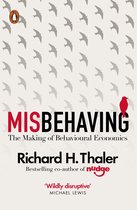MISBEHAVING
Richard H. Thaler
Rymenans Sarah S0202996
Universiteit Antwerpen
,Content
1. BEGINNINGS 1970-1978.....................................................................................................................2
1.1 Supposedly irrelevant factors.......................................................................................................2
1.2 The endowment effect.................................................................................................................3
1.3 The list..........................................................................................................................................3
1.4 The value function........................................................................................................................3
1.5 California dreaming......................................................................................................................3
1.6 The gauntlet..................................................................................................................................4
2. MENTAL ACCOUNTING: 1979--1985...................................................................................................4
2.7 Bargains and rip-offs.....................................................................................................................4
2.8 Sunk costs.....................................................................................................................................5
2.9 Buckets and budgets.....................................................................................................................5
2.10 At the poker table.......................................................................................................................5
3. SELF-CONTROL: 1975 – 1988..............................................................................................................5
3.11 Willpower? No problem.............................................................................................................5
3.12 The planner and the doer...........................................................................................................6
INTERCLUDE...........................................................................................................................................6
13 Misbehaving in the real world.......................................................................................................6
4. WORKING WITH DANNY.....................................................................................................................7
4.14 What seems fair?........................................................................................................................7
4.15 Fairness games...........................................................................................................................8
4.16 Mugs...........................................................................................................................................8
5. ENGAGING WITH THE ECONOMICS PROFESSION: 1980-1994............................................................9
5.17 The debate begins......................................................................................................................9
5.18 Anomalies...................................................................................................................................9
5.19 Forming a team...........................................................................................................................9
5.20 Narrow framing on the upper East side......................................................................................9
6. FINANCE: 1983-2003........................................................................................................................10
6.21 The beaty contest.....................................................................................................................10
6.22 Does the stock market overreact?............................................................................................10
6.23 The reaction to overreaction....................................................................................................10
6.24 The price is not right.................................................................................................................11
6.25 The battle of closed-ed funds...................................................................................................11
6.26 Fruit flies, icebergs and negative stock prices...........................................................................11
7. WELCOME TO CHICAGO: 1995-PRESENT..........................................................................................12
1
, 7.27 Law schooling...........................................................................................................................12
7.28 The offices.................................................................................................................................12
7.29 Football.....................................................................................................................................12
7.30 Game shows.............................................................................................................................13
8. HELPING OUT: 2004-PRESENT..........................................................................................................14
8.31 Save more tomorrow................................................................................................................14
8.32 Going public..............................................................................................................................14
8.33 Nudging in the UK.....................................................................................................................14
CONCLUSION: WHAT IS NEXT?.............................................................................................................15
1. BEGINNINGS 1970-1978
1.1 Supposedly irrelevant factors
When he was teaching a micro economics class and he graded the exams his students took they
weren’t happy with the scores when they received them back. They argued that the exam was too
2
,hard, and because he was still at the beginning of his career he didn’t want to lose his job so he
changed the exams. He didn’t make the exams easier but asked questions on a total of 137 point
instead of 100. When the students got their results back they were a lot happier than a year before,
even though their scores slightly dropped. This was due to the fact that the average score was
around 90 and thus gives a feeling that you did well on the exam, and many students were too lazy to
actually calculate their results, because you can’t divide by 137 by hard. This behaviour is not
consistent with the theory of econs, and his students were thus misbehaving.
1.2 The endowment effect
When using a credit card this creates a cost for the storeowner and therefor they charge different
prices when you pay cash or with a credit card as a customer. However there is a difference between
setting the cash price as standard and asking a surcharge for paying with your credit card, or setting
the credit card price as standard and giving a discount when a customer pays with cash. For an econ
this would be exactly the same, but not for humans due to framing. The surcharge would be an out-
of-your pocket situation whereas the discount would be a mere opportunity cost, and thus less
important. This is called the endowment effect, people value thing that they own more highly than
thing that aren’t part of their endowment.
1.3 The list
he drew a list on the blackboard of things that humans did that were inconsistent to what econs
would have done in the same situation. For example not going to a game due to a storm when you
got the tickets for free, but saying you would have If you would have bought the tickets. These errors
occur due to the bounded rationality people have, we aren’t able to solve complex problems. And
thus humans aren’t able to optimize in a way that is expected econs do in economic theories.
Economist brushed this aside by stating that these errors were random, however they aren’t and
thus don’t even out to zero. These are predictable errors which means you need to take them in to
account when formulating theories.
1.4 The value function
The value function shows people’s happiness to changes in wealth. When you keep on increasing
wealth it will have less of an impact on the happiness, and the same thing goes for a decrease, when
you keep on decreasing the wealth, the last 10€ will hurt less than the first. This explains why
humans are risk averse for gains and risk seeking for losses. We value the first 100€ gain more than
the following so we will choose the safe option. But the second 100€ loss hurts less than the first so
we are willing to take a bet. However, the effect of a decrease of wealth is much sharper, than the
increase of wealth. This shows that a decrease affects the happiness of a person more than an
increase, this shows the endowment effect.
1.5 California dreaming
When creating his list a few chapters ago he used his intuition as to whether these things happened
in the real world. However he knew this wasn’t the best approach to it. During that time the most
common way to test this was to use experiments so that was what he did. He used the example of a
jacket and a calculator (which cost less), on both items you get the same discount of 10€ however
you will have to go to a story that is a 20 minute drive away. Most people will do this for the
3
,calculator but not for the jacket. He now had a slow hunch, this means that he didn’t have an aha-
moment but rather an idea that could potentially lead to a dead end, and he didn’t know what was
the next step.
1.6 The gauntlet
The gauntlet was a list of thing economist said to him as to why behavioural economics was
irrelevant. In those times traditional economics was mostly based on mathematics and was based on
rational decision making. One of the reasons why behavioural economics was to be brushed aside
was as if, if people didn’t know how to act like an econ that would act as if they knew. A debate was
opened whether this was true, economic theory says that a firm maximises profit when the marginal
income is equal to the cost of an extra employee. A research was set up that asked multiple
managers how they determined whether to hire an extra employee or not. None of them answered
anything near the theory. However traditional economist countered this by saying that managers
have a instinct of how many they should hire that comes close to the theory, but without showing
any data.
2. MENTAL ACCOUNTING: 1979--1985
2.7 Bargains and rip-offs
When buying something humans experience acquisition utility and transaction utility. Acquisition
utility can also be referred to as consumer surplus and thus is the difference between how much you
value the thing that you just bought and how much it has cost you (the opportunity cost).
4
, Transaction utility is how good or bad the deal made you feel. When buying something we have a
reference price in our mind (the price we expect to pay for a certain good), when we pay less we feel
good, when we pay more we feel bad. Econs however, only experience acquisition utility, transaction
utility is an SIF for them. Stores use this on good that are infrequently bought and where the quality
is hard to measure, they set a retail price that is high, and always give a discount, to make the
customer think they scored a good deal.
2.8 Sunk costs
When you paid a certain amount for something that is non-refundable this is called a sunk cost. For
econs sunk cost are not relevant and they don’t put any attention towards it. However for most
humans this is another story. When you buy for example new shoes that you aren’t able to return,
but when you wear them your feet hurt after a while. Most people will still continue to wear those
shoes accordingly to how much they have cost them. Because the more people use a certain item
they have bought the less it feels like a loss. An interesting fact about these sunk cost is that they
become more vague over time, in the beginning you will find it very sad that you bought shoes that
hurt when you walk in them so they don’t get the use you expected to get out of them. But after a
while this feeling decreases so that it doesn’t bother you as much anymore as in the beginning.
2.9 Buckets and budgets
When he studied the financial decisions a-of a group of lower class households he discovered that
most families worked with a system of envelopes in which was the money for a category for example
groceries, vacation,… . Company’s often work the same way so that the CEO doesn’t have to approve
of every payment that happens. However, this can cause silly situations, for example important
things that need to be bought but aren’t due to the fact that the budget is down to 0 for that
particular time period. In families bad decision making was noticed during the beginnings of the
financial crisis, gasoline prices dropped by half the price. So that families could spend half of their
gasoline budget on something else. It would be reasonable to spend this money on more trips, or for
example a nice peace of clothing, however a decent amount of families spend it on ‘better’, and thus
more expensive gasoline.
2.10 At the poker table
When people are confronted with big losses, they are willing to take more risks than they usually
would when they have a chance to break even. An example of this are horsing races in which betters
who are in red at the end of the day are likely to put a small amount of money on a horse that has a
small probability of gaining a lot of money for the better. People thus have a preference for a small
bet with a tiny probability of success rather than a larger bet with a higher probability of success.
Another concept handled in this chapter is playing with the money of the house, when you have a
win early on the evening in a casino, most people will treat this money they have just won differently
than the money they brought themselves. They will put the money of their own in their pocket and
start gambling (with more risks) with the other money. Even though you have just won the money,
doesn’t mean that you have to treat it differently
3. SELF-CONTROL: 1975 – 1988
3.11 Willpower? No problem
When you buy something today it’s worth more to you than when you would have to wait a year
from now to buy it. People are said to discount consumption at a certain rate. An economic model
has been made to capture this system called intemporal choice, that used indifference curves. An
5





